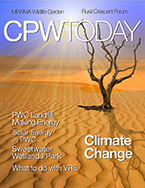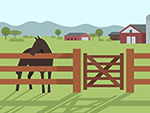Many thanks to Kinnett Plumbing
for fixing plumbing problems at the Stone House at Merrimac Farm!
In this Issue
Policy Changes for the Rural Crescent?
What is the Purchase of Development Rights?
VRE Expansion: A Fork in the Road
Commercial Development Committee Seeks Reduced Buffers
Native Plant Workday
Save the Dates! |

The latest issue of Conserve Prince William Today is hot off the presses. Click HERE to read.
There's so many great articles and videos this edition, it's hard to know where to start!
Don't miss the cool shots from a drone flying over the Merrimac Farm Wildlife Garden.
Find out how one Manassas Family made the switch to solar power and view Potomac River Eagles from hatchling to fledgline.
Catch up on Rural Crescent events - watch speaker highlights from the July Forum with Mike May, Charlie Grymes, and Supervisor Jeanine Lawson.
Learn more about TOD and the Virginia Railway Express, including proposed service to Haymarket.
Read more HERE. |
What is the Purchase of Development Rights?
PDR programs are a meaningful, well known and essential tool in rural preservation toolboxes.
In a PDR program, government agencies (sometimes with other partners) reduce the number of houses that could be built in an area by purchasing the development rights from private landowners.
After development rights are purchased, the parcels are permanently protected from new development.
PDR programs are voluntary; purchases are made only from willing sellers and no one is compelled to sell.
The state of Virginia provides some funding to local governments to purchase development rights.
The Military Encroachment Partnering Program offers matching funds to support the purchase development rights for properties around the border of military bases, such as Marine Corps Base Quantico.
In neighboring Fauquier County, their PDR Program has protected more than 10,500 acres of land, funded through a special real estate tax levy currently set at just $0.006 per $100 of assessed value. |
 Your generous gifts help us stay strong and remain a critical local voice for healthy communities. If you haven’t yet joined or need to renew your membership, please consider doing so now!
Your generous gifts help us stay strong and remain a critical local voice for healthy communities. If you haven’t yet joined or need to renew your membership, please consider doing so now! |
Native Plant Workday!
Join us on Saturday morning, August 6, 9:30am to help remove invasive plants that are infiltrating the native plant buffer by K9Gunner Dog Park on Minnieville Road. For questions and to RSVP, contact us at alliance@ pwconserve.org or 703.499.4954 |
Save the Date!
PWCA Open House
Wednesday, September 21, beginning at 5pm
Street Trees Walking Tour
Saturday, September 17, 10am |
|
| Policy Changes for the Rural Crescent? |
 This Wednesday, August 3, the Board of County Supervisors (BOCS) will consider Planning Director Chris Price's proposal to open a long list of Comprehensive Plan updates, including reconsideration of Rural Crescent policies. This Wednesday, August 3, the Board of County Supervisors (BOCS) will consider Planning Director Chris Price's proposal to open a long list of Comprehensive Plan updates, including reconsideration of Rural Crescent policies.
When the BOCS adopted the Rural Crescent in 1998, their primary goal was to constrain the rising costs of providing public infrastructure and thus limit property tax increases. Designation of the Rural Crescent also created the opportunity to preserve green open space and farmland.
The County has not acted on that opportunity – yet. Despite considerable talk over the years, incentives for farmers and open space initiatives are largely unchanged.
A Purchase of Development Rights (PDR) program, as called for in the Comprehensive Plan and recommended by the 2014 Rural Preservation Study, has not yet been adopted.
PDR programs are a tried and true incentive that protects farmland and open space… and does not require the approval of new homes in either the rural or development area.
In Prince William, farmers already struggle with diminished opportunities to secure adequate land for farming operations. They rightly want to know if Prince William County is serious about protecting farmland.
Adopting a PDR program would accomplish this goal and also signal a commitment to re-development and open space initiatives. According to the County’s 2014 Rural Preservation survey, Prince William residents support PDR programs and most say they are willing to pay to protect open spaces.
The Planning Office is proposing a piecemeal approach to update the Comprehensive Plan. Prince William Conservation Alliance supports a comprehensive approach that includes community involvement to ensure consistency between individual chapters.
PWCA also urges the BOCS to reject initiation of any discussion or investment of staff resources aimed at revising Rural Crescent policies before implementing and evaluating a funded PDR program – a fundamental and essential tool commonly used to protect rural areas and their associated countywide benefits.
Click HERE to read more. Make sure your voice is heard! Click HERE to share your views with Supervisors. |
| VRE Expansion: A Fork in the Road |
 The Virginia Railway Express (VRE) is planning to expand, and now faces a fork in the road. The Virginia Railway Express (VRE) is planning to expand, and now faces a fork in the road.
Option A: It can focus on increasing service, adding more trains and operating every hour during the day to carry passengers from the outer suburbs into the urban core.
To store the additional trains, the current Broad Run station would be converted into a larger railyard/maintenance facility. A replacement station for passengers would be built at Godwin Road, on the same track and 1.5 miles closer to Manassas, or at Innovation.
Option B: VRE's alternative is to build 11 miles of new track west to Haymarket. That new track would be built next to the existing Norfolk Southern tracks, and new stations would be built at Innovation, Gainesville, and Haymarket.
The Haymarket alternative would cost an additional $250-$350 million for construction, plus an additional $9 million for annual operations. It would remove an additional 100 cars/day from I-66.
Getting cars off I-66 is a good thing but the costs would be stunning: $3 million/car for VRE construction and an additional $30,000/year/car for annual operations.
Building out to Haymarket requires building a new industrial railyard within the Rural Area. VRE officials justify the extra costs by citing how transit will increase development.
Spurring transit-oriented development is a great argument - for building at Godwin Road or innovation, not at Haymarket. Just who really wants taxpayers to provide an additional $30,000/year per car so VRE can incentivize sprawl and help "bust" the Rural Area urban growth boundary?
There's more detail in several blog posts at https://pwconserve.wordpress.com |
| Commercial Development Committee Seeks Reduced Buffers |
 Prince William County’s Commercial Development Committee (CDC) includes representatives from local developers, PWC and Manassas Chambers, the Northern Virginia Building Association, land use attorneys, and companies that provide developer services. Prince William County’s Commercial Development Committee (CDC) includes representatives from local developers, PWC and Manassas Chambers, the Northern Virginia Building Association, land use attorneys, and companies that provide developer services.
The CDC is staffed by representatives from the County’s Land Development Division, Public Works, and the Fire Marshall.
This Committee recently recommended that the Board of County Supervisors (BOCS) re-evaluate “buffer requirements to reduce their impact on business development.”
In early June the BOCS started the process when they voted unanimously to initiate amendments to the Zoning Ordinance and Design & Construction Standards Manual.
Buffers are vegetated areas that help avoid conflicts between abutting land uses, shield unattractive public and private infrastructure, and are required along the edges of some streets, as identified by Highway Corridor Overlay Districts.
In some developments buffers may be the only substantial green space that exists. Buffers protect residential areas from more intense commercial uses, create visually attractive streetscapes, protect streams, help manage stormwater runoff, improve the appearance of our communities, and increase property values.
Despite the many benefits, developers are focused on maximizing buildable land and not on long-term benefits. They are asking for changes to all zoning districts and uses, including to buffer sizes.
The CDC is also requesting approval to “share uses” within buffers, such as with utilities, stormwater management structures and other. Adding infrastructure to buffers would make the retention of undisturbed buffers near impossible and as for re-planting, you can’t plant trees on top of utility lines.
These proposed changes to the County’s minimum development standards are currently under review by County staff and the Development Ordinance Review Committee, also heavily populated by developer interests.
Make sure your voice is heard! Click HERE to email Supervisors.
Also contact staff, email addresses below, and include a request to forward your comments to the Development Ordinance Review Committee.
Learn more about the value of protecting green spaces on this great webpage by the University of Washington HERE.

|
|
|